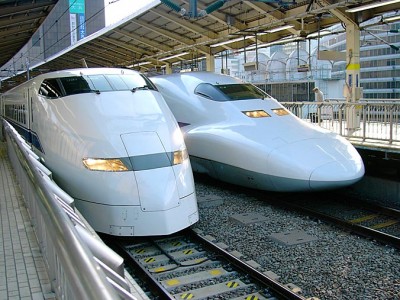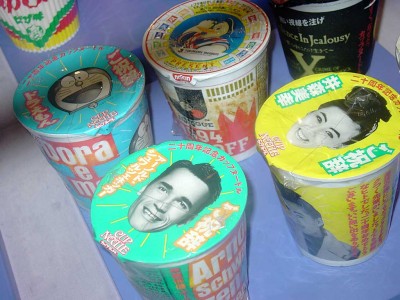For Your Ramusement
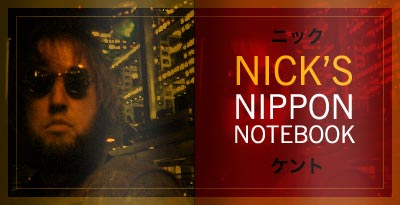
I’ve often read about many unusually specialized museums in Japan such as the Towel Museum. One of the better known ones that I’ve actually been to is the Shinyokohama Raumen Museum. I’ve noticed various Blogs and Village Voice restaurant critics have called a Ramusement Park, though I’m pretty sure it’s a case of a witty phrase made up by some blogger and cut and pasted around on the net. Hey, convince me otherwise.
I guess the name itself deserves a short FAQ. Shin-Yokohama is the area around the Shinkansen Station (Japan’s high speed “bullet” train). Though in context “Shin” means “New”.
The first leg of the Shinkansen was opened in 1964, the year of the Olympics. 1964 was a major turning point in terms of modern Japan. Tokyo Tower, Tokyo’s iconic life size Eiffel Tower replica built in 1958 often represents the start of the re-modernization of Tokyo with Olympic games being the culmination. Because it needed new tracks some cities could accommodate the Shinkansen in their main station (like Tokyo) but others needed a new station because too much city was in the way (Osaka). Yokohama was one of those cities with it’s separate, less central Shin-Yokohama station.
Yokohama was opened as a port and city to foreigners in the mid 19th century. With Tokyo to the north the pair of cities became a major megalopolis and I often forget Yokohama is another gigantic city a half hour or so south that has it’s own history and personality and is, by most accounts, Japan’s second largest city (though depending on criteria it’s possible to make metropolitan Osaka bigger, but then you get into issues of what the city proper is and Osaka being part of a large metropolitan area with Kobe and Kyoto with numerous smaller cities not being part of say Osaka proper. What’s interesting and sensible is Yokohama doesn’t try to duplicate Tokyo much since it’s maybe 40 minutes by normal speed train from the heart of Tokyo.
One thing is Yokohama has a fairly large Chinatown dating back to the 19th Century. Ramen, or as the museum spells it Raumen, are noodles in soup that everyone agrees were somehow inspired by Chinese cuisine. The name even seems similar to lo mein but there is debate to what extent it was as there are other theories. It most likely evolved from Chinese food in the 19th century and was adjusted to be more Japanese somewhat like curry, which also happens to also have a museum in Yokohama under the same ownership and is a Japanese take on British powdered Indian curry and can maybe not coincidentally be a flavor of ramen.
The Raumen Museum displays focus on instant ramen which was invented in 1958 by Momufuku Ando of Nissan foods. Interestingly at the time instant ramen eaters initially paid a high price for convenience over restaurant ramen though prices are the opposite now unless a restaurant is having a special.
Apparently there is a newer, Nissin operated Instant Ramen Museum near Osaka. I would guess the Shin-Yokohama museum inspired the company to open their own museum.
Inside the Shin-Yokohama Museum, after paying a $3 or so admission there is a typical historical display with some neat packaging and a fair amount of very old looking instant ramen plus a gift store with souvenirs and of course a lot of instant ramen not generally available as well as frozen ramen. I think I ate too much instant ramen being a cheapskate on my earlier trips and then for a while in NYC while working in an office. Lately I’ve been eating kind of pricey ramen once a week at Ippudo NYC, which is absolutely incomparable to instant ramen and the best ramen I’ve eaten anywhere.
The centerpiece of the museum is a recreation of a block or so from 1958, at the birth of instant ramen.
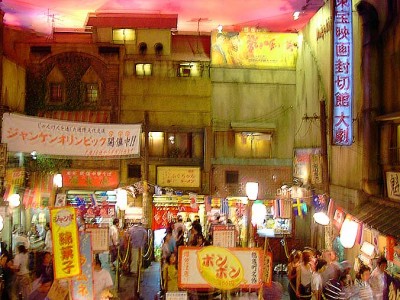
There are a few gift and snack shops selling newly made nostalgic snacks and nicknacks. There is clearly a niche market in Japan for newly manufactured retro-styled snacks and toys. Mostly though, the block has a number of operating ramen restaurants. I did find it interesting that they chose 1958 because that meant instant ramen, though clearly ramen restaurants are still here to stay.
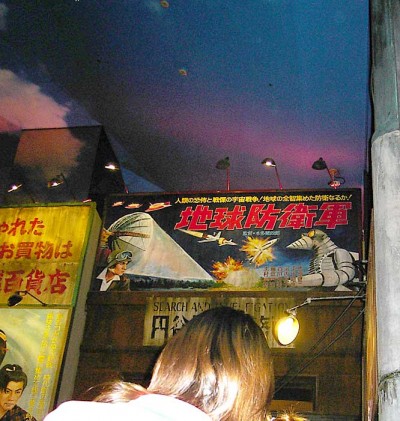
I spotted a poster from the 1957 Toho Science Fiction film “The Mysterians”. (named “Earth Defense Force” in Japan and considered part of the Godzilla universe)
They had basic brochures in English and Korean. It had some basic facts and explained that small ramen shops typically utilize a ticket machine outside the restaurant. You push the button for the ramen and extras you want, pay and you get a ticket. Though not explained the restaurant clearly no longer needs a cashier or the space it consumes as well as the ramen makers can keep their hands clean without handling money.
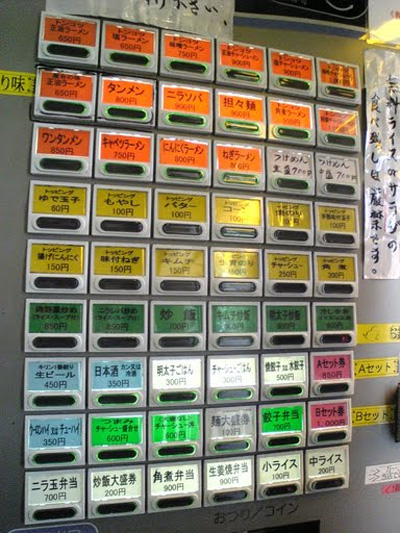
Above: This photo of a ticket machine is not one in the museum.
Each restaurant only had a tiny seating area and had it’s own line marked by a rope outside. As a guide there were signs along the length of the line pointing out say an approximately 10, 15, 25 minute wait, etc. at different lengths from the front door
A huge frustration for non-Japanese was that while there were a couple small unclear photos on some machines, most choices were entirely in Japanese text. That got me really frustrated as I kept thinking I don’t really want to order a random ramen after a 20 minute wait so I left hungry without buying a ticket.
Nick Kent is a New York based artist who works with electronic media and is an occasional pop culture pundit.















